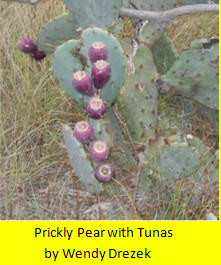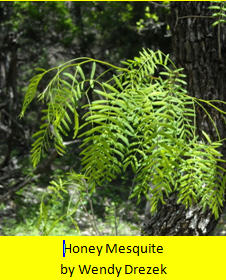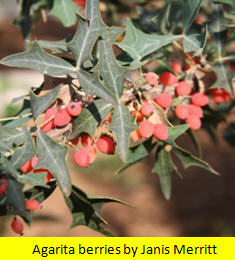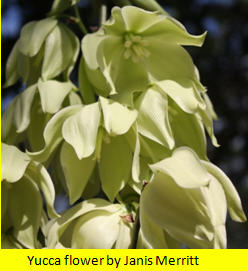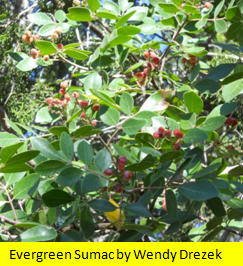Guide to SA Natural Areas & Linear Creekways
V. Ethnobotany
Note: Do not eat any plant unless an expert has identified it, as there are similar, harmful plants.
Written by Alamo Area Master Naturalist Janis Merritt.
EARLY USES OF PLANTS
While visiting Hardberger Park, you will see many indigenous plants that were used by Native Americans and the early Texas settlers. These plants provided food, medicine, tools, weapons, dyes, and building materials, sustaining life in a challenging environment.
ACORN AND MESQUITE FLOUR
Several species of oaks such as Live Oak, Spanish Oak, and White Shin Oak are found in our Natural Areas. Acorns from oak trees were considered the “staff of life” by Native Americans and early Texas settlers. The acorns were gathered, tannins leached, and then ground into a flour. Acorns are rich in protein, fat, and calcium. Honey Mesquite trees also provided an important food source. The edible pods, ground into flour, also are high in protein and contain calcium, iron and other minerals. The green pods were chewed as a sweet candy; Mesquite bean jelly is a delicious jelly even made today. Mesquite had many medicinal uses including an eyewash for conjunctivitis and digestive problems.
MESQUITE WOOD
The wood was used for making tools such as atlatls, digging sticks, pestles, and war clubs. The wood is said to be twice as hard as oak or walnut and is used in flooring, furniture, doors, and fireplace mantles. In the 1800s and early 1900s hexagonal mesquite blocks were used in roads in the Alamo Plaza and San Antonio downtown streets to combat the mud during rainy weather.
ASHE JUNIPER POSTS
Mountain Cedar or Ashe Juniper has decay-resistant wood useful in building construction and for fence posts. Native Americans used the “berries” (actually cones) to flavor meat and stews. Smashed juniper “berries” can be used to repel mosquitoes. Cedar wood oil is shipped all over the world to scent soaps, perfumes, room sprays, and cosmetics.
AGARITA JELLY
The yellow wood of Agarita was used to dye baskets and buckskin. The antiseptic quality of the root and bark was used to treat wounds, skin, or gum problems. The edible red berries are used to make a delicious jelly and wine.
PRICKLY PEAR PODS & TUNA
Prickly Pear cactus pads and fruits are edible. The oblong fruit, termed tunas, are edible raw or used in jellies and are a source of potassium, beta carotene, vitamin C, calcium and phosphorus. The pads can be eaten raw or cooked and also provide beta carotene and potassium. The pads were used as a poultice to treat inflammation. The fruit of the Hackberry are also edible and have twice the protein of domestic raisins. These same berries were also used for treating dysentery.
YUCCA FLOWERS AND GREENBRIER SHOOTS
The useful Yucca plant was a source of food, fiber, and soap. The edible flowers are high in vitamin C and can be eaten raw, pickled, fried, or sautéed with onions and tomatoes. Yucca leaves are used for fiber for making twine. Saponins in the yucca root make a good soap for washing clothing, hair, and bathing. The tender young shoots of the thorny Greenbrier vine are edible raw, used in salads, cooked in soups, steamed or sautéed. It has nine times the sugar value and two times the protein value of spinach.
SOTOL: MAJOR FOOD SOURCE
Sotol is another plant found in our Natural Area parks. It was once a major food source for Native Americans. The bulb or "heart" of the plant was roasted in a pit lined with hot rocks for approximately 48 hours, which made the pulp soft and sweet. Sotol leaves were used for making baskets, mats, sandals, and rope. The woody flowering stalk was used in building construction and for fuel. Today some people use the stalk for a walking stick.
MULTI-USE EVERGREEN SUMAC
One final example of an important native plant that helped Native Americans and early Texans survive is Evergreen Sumac. Sumac berries were used to make a refresing beverage with a taste similar to lemonade. Berries were also dried and stored during the winter. They area high in vitamin C and good for colds, fevers, and scurvy. The leaves, inner bark, and root bark of sumac were used for urinary infections, sore throats, gum problems, cold sores and other medicinal uses. Compresses were applied to burns and cuts to stop bleeding and bring down swelling. Native Americans mixed clay with ground berries for use as a poultice on open sores and arrow wounds.
As you enjoy hiking in our Natural Areas, taking in the lovely flower and fruits and stopping under the shade of a large native tree, remember how important many of these plants were to the Native Americans and early settlers of Texas.
